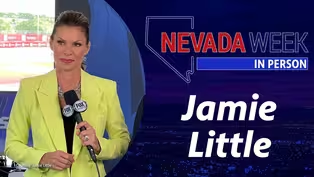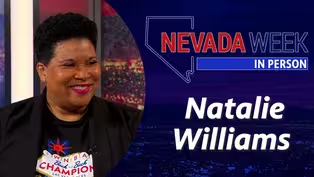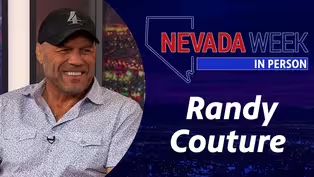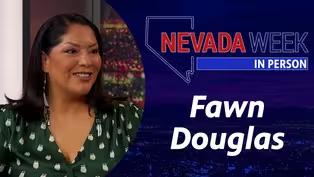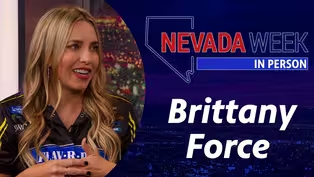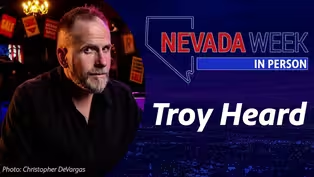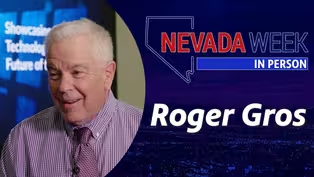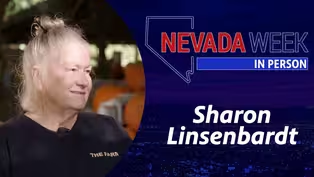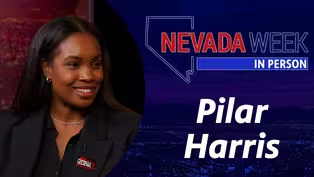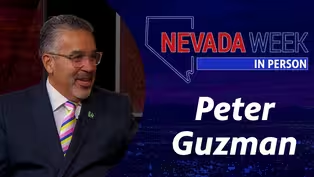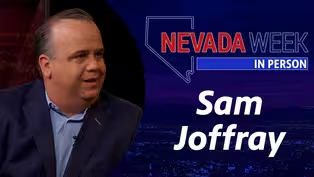
Nevada Week In Person | Kumud Acharya
Season 1 Episode 65 | 14mVideo has Closed Captions
One-on-one interview Desert Research Institute President Kumud Acharya.
One-on-one interview Desert Research Institute President Kumud Acharya.
Problems playing video? | Closed Captioning Feedback
Problems playing video? | Closed Captioning Feedback
Nevada Week In Person is a local public television program presented by Vegas PBS

Nevada Week In Person | Kumud Acharya
Season 1 Episode 65 | 14mVideo has Closed Captions
One-on-one interview Desert Research Institute President Kumud Acharya.
Problems playing video? | Closed Captioning Feedback
How to Watch Nevada Week In Person
Nevada Week In Person is available to stream on pbs.org and the free PBS App, available on iPhone, Apple TV, Android TV, Android smartphones, Amazon Fire TV, Amazon Fire Tablet, Roku, Samsung Smart TV, and Vizio.
Providing Support for PBS.org
Learn Moreabout PBS online sponsorshipMore from This Collection
Nevada Week In Person goes beyond the roundtable discussion of Nevada Week with guests for a more casual conversation about their personal passions, new projects and compelling stories that are overlooked in the flurry of the news cycle.
Nevada Week In Person | Jamie Little
Video has Closed Captions
One-on-one interview with Jamie Little, NASCAR Broadcaster (14m)
Nevada Week In Person | Chet Buchanan
Video has Closed Captions
One-on-one interview with Chet Buchanan,Host & Creator, 98.5 KLUC’s The Chet Buchanan Show (14m)
Nevada Week In Person | Natalie Williams
Video has Closed Captions
One-on-one interview with Natalie Williams, General Manager, Las Vegas Aces (14m)
Nevada Week In Person | Randy Couture
Video has Closed Captions
One-on-one interview with Randy Couture, UFC Hall of Famer & U.S. Army Veteran (14m)
Nevada Week In Person | Fawn Douglas
Video has Closed Captions
One-on-one interview with Fawn Douglas, Artist and Activist, Nuwu Art (14m)
Nevada Week In Person | Brittany Force
Video has Closed Captions
One-on-one interview with Brittany Force, World Champion Drag Racer (14m)
Nevada Week In Person | Troy Heard
Video has Closed Captions
One-on-one interview with Troy Heard, Artistic Director, Majestic Repertory Theatre (14m)
Nevada Week In Person | Roger Gros
Video has Closed Captions
One-on-one interview with Roger Gros, Publisher, Global Gaming Business Magazine (14m)
Video has Closed Captions
One-on-one interview with Sharon Linsenbardt, Owner, Las Vegas Farm and Barn Buddies Rescu (14m)
Nevada Week In Person | Pilar Harris
Video has Closed Captions
One-on-one interview with Pilar Harris (14m)
Nevada Week In Person | Peter Guzman
Video has Closed Captions
One-on-one interview with Latin Chamber of Commerce Nevada President & CEO Peter Guzman (14m)
Nevada Week In Person | Sam Joffray
Video has Closed Captions
One-on-one interview with Sam Joffray, President & CEO, Las Vegas Super Bowl LVII Host Com (14m)
Providing Support for PBS.org
Learn Moreabout PBS online sponsorshipThe globally recognized Desert Research Institute confronts crucial environmental concerns, and its president, Kumud Acharya, is our guest this week on Nevada Week In Person.
♪♪♪ Support for Nevada Week In Person is provided by Senator William H. Hernstadt.
-Welcome to Nevada Week In Person.
I'm Amber Renee Dixon.
With 20-plus years of experience in environmental study, he right now manages more than 450 scientists, engineers, and support staff at two state of the art research campuses in Las Vegas and Reno.
Kumud Acharya, ninth president of the Desert Research Institute, thank you for joining us for Nevada Week In Person.
(Kumud Acharya) I'm pleased to be here.
Thank you for having me.
-So DRI has been around since 1959.
As we mentioned, its focus is on research to address environmental concerns.
Right now, what is the most important research you're conducting, in your opinion?
-Sure.
There are so many, but I think the most pressing one right now is I have to start with drought.
Southern Nevada, I'd say the entire western United States, is really undergoing a massive drought problem.
So there are a number of topics within drought that DRI scientists are working on right now.
For example, our scientists have developed a new technology.
It's called OpenET.
Working with USGS, NASA, and Environmental Defense Fund, what this new tool does is it allows farmers or ag growers to basically understand how much water is being transpired from their plants' field.
It's basically measuring evapotranspiration using satellite images' data.
-So how would that aid in relieving the drought?
-Right.
So what that does is it allows us to-- farmers to conserve water.
They'll understand how much or whether their plants are transpiring using more water than they should be, or how can you make their plants or fields more water efficient, right?
So that's a conservation practice, right?
So that allows us to save water.
That water then can be used in other areas.
Talk about cloud seeding.
You may have heard about cloud seeding.
DRI is one of the pioneers in cloud seeding technology and practices.
We've been doing cloud seeding since early 1970s in the state.
-"Transpiring," first.
What does that mean?
-Transpiring means, you know, basically, the plants take water from the soil, and then they will release that water to the atmosphere.
-And you can track this using satellite imagery?
-Yes.
-Wow!
And then the second point that you mentioned of the research that you're conducting and participating in, "cloud seeding."
For those who don't know, what is that, because it kind of blows my mind.
-What cloud seeding is, is that basically releasing a harmless chemical compound into the atmosphere when there's a lot of moisture, especially if this is done in winter months.
Then that increases the amount of precipitation.
There's a potential for increase by 10 to 15%.
-Wow!
-So we have-- DRI has, right now I believe, more than two dozen generators spread across Nevada and Colorado and Utah that can be fired up whenever there is a, like somebody, like those generators already in place.
Like there's one in Red Rock.
-Right.
-You know, there's one in Mount Charleston.
So in winter months, those generators can be fired to increase precipitation.
I mean, we don't need to do that this year, because we got a lot of precipitation.
But remember, we have a 20-year drought going on here.
Right?
So that cloud seeding is another program where we're-- that'll help us to deal with drought.
DRI also has, not many people are aware, one of the six national, or regional I would say, climate centers.
There are six climate centers in the country, and Western Regional Climate Center is housed at DRI since 1980s.
We have more than two dozen, I say 30, scientists working on understanding the impact of climate on drought and water resources or everything.
And we have excellent weather forecasters at DRI.
-And who are the important people that are utilizing this research you do?
-Policymakers, states, the federal agencies, the private foundations.
It's open to public.
Everything that we produce, we do, is available for everybody to see.
-Talking about the public and climate change, there are people who do not believe that it's real.
There are people who do not believe that COVID is real.
There are people that are denying science.
And this denial of science that we're seeing, I wonder how it impacts you.
-It really doesn't.
Well, it disheartens somebody like me who is a scientist, but our goal does not change.
We don't take part in political discussions.
We're non biased.
Research Institute, our job is to collect data and analyze that data and put it out there for people to make interpretation.
And so we provide facts.
So it doesn't change.
Nothing has changed since the COVID or since, like you know, people talk about climate.
I'm not here to argue about climate change.
But I'll tell you something, I'm seeing data that shows the sea level is rising.
Right?
And we're seeing disparities in floods and drought.
The dry places are becoming drier.
The wet places are becoming wetter.
There are more floods, more dry places.
It's happening.
It's there.
The data is there, you know?
-So you're not political.
DRI is not political; however, you interact with a lot of politicians, and you also receive funding from groups.
We've talked about, in the control room, Tesla funding a robotics program.
-Yep.
-And so they have political leanings sometimes, these companies.
How do you go about maintaining neutrality?
-You know, we work with people of all spectrum, all beliefs.
And so our job is to collect data and then help solve problems.
Right?
And so people, they want to see solutions, and that's what we provide.
So it really does not impact us when we're dealing with-- We work with Republicans, Democrats, people of all walks of life.
-I want to talk about your personal career.
And perhaps, is there a moment in which your research surprised you, devastated you, overjoyed you, or changed you as a person?
-Overjoyed is a interesting one because, and I'll tell you something, a research hasn't impacted me profoundly.
But during the course of the research, the things that I've seen, the places that I visited, the challenges that I've seen, they have certainly changed me and my perspective.
I'll give you a couple of examples.
I was invited by a couple of my colleagues, European colleagues, to go to Indonesia one time to work in a village.
And they explained to me that that village, people are very poor.
They don't have drinking water supply.
There's no pipelines like here.
They actually have to-- They get a lot of rainfall in winter.
There's nothing in summer, so they have to actually capture that rainfall from winter, save it for summer, and when they run out, they actually have to sell their cattle to buy drinking water.
And they said, Do you want to go and work with us?
I said, Great.
So we raised money from Rotary clubs around the world.
And I went and lived in a village for a month, building rainwater harvesting system for that village.
We built 60 tanks, and then we built collection system.
And the joy that you see in their people's eyes, you know, it's life changing.
-And how did it change your life?
-That changes, you know, the importance of things here.
I think the things that we talk about, we complain here, those are trivial compared to the hardships those people go through.
That's what changed my perspective in many ways.
Listen, I grew up in Nepal.
Nepal is one of the poorest countries in the world.
I grew up in the capital, Kathmandu.
But in Nepal, it's a very difficult terrain.
It's-- 60-70% of Nepal is mountainous, because we have the tallest mountain in the world, Mount Everest.
So from sea level to like 8,800 meters, right?
And so people live in villages.
Sometimes women who do the household work, they have to walk a mile to get a bucket of water.
I've seen that growing up.
Not in capital, in visiting those places.
And that's what changes your perspective in life.
-Is that what led you to have a passion for water?
-Absolutely.
Absolutely.
-How else did you get involved in science?
So from the Nepal, born and raised there, you came to the U.S. in 1993 as a Bradley University graduate, got your PhD in environmental science in Japan, where did this passion for science stem from?
-So growing up, one thing that my parents told me was, You want to go places, get educated.
And that's exactly what I did.
So I was really, I was good at math.
I liked math.
So when you're, when a subject that comes easy for you, then you say, okay, maybe I should do study something related to math.
And I decided to get into engineering, but to get into engineering, then I had to take physics, chemistry, and learn all the science.
And that's how I got involved in-- So I have a civil engineering undergraduate degree and then the Masters and PhD in environmental and biology.
So yeah, that's how I got into STEM education.
-When you tell people about that, what can they take away as far as, Gosh, you can start in one line of work and end up in something different.
-I'd say that STEM education is so important.
It opens so many opportunities for you, whether it's science, whether it's technology, whether it's math.
Listen, I started as a math student and became a science leader here in the United States.
So, yeah, I think that whatever speaks to you, right?
Something that you're good at or you want to learn about, just pursue your passion, you know, and that will take you to places.
-Science leader, I like that title.
Your parents, they must be awful proud of you.
-They are.
They are.
My parents are very proud.
I'm a second generation U.S. graduate.
My father also went to school here, but he did not live here.
He went back to Nepal, and he lives in Nepal right now.
-I want to elaborate on STEM education.
Speaking of politicians, you were with U.S. Representative Susie Lee recently, who talked about getting funding, securing funding to advance STEM program here in Nevada.
And she says it can diversify the economy here, which we know is in need of it, away from gaming and tourism.
How does it do that?
-So that's a great question.
So let me talk a little bit about DRI's STEM program and why it is important.
We have, as you said, in the beginning, more than 450 people working at DRI.
At any time, we have more than 100 different science topics being researched on or trying to find solutions for.
And then all of the science, that science that we do, we would like to translate or explain that science to community and people.
Right?
How do you do that?
How do you translate that science that happens at DRI and tell that to kids, like, Hey, science is fun.
Science is important.
So that's what led to DRI's STEM program.
We said okay, let's-- We have all the scool science.
Let's develop educational materials around our research, and let's use that to educate our children.
Right?
For example, you talking about recycling, right?
So what about we created a recycling tool or a small mini lab that we can take to schools and then tell kids, Hey, this is how the recycling works, this is how you save water, this is how you reuse plastics, and things like that.
So that led to DRI's STEM program where basically we're trying to use our science to teach them different, different things.
And so we have a excellent program called Science Alive at DRI.
We have 40 different topics in science that we actually-- These are called green boxes.
Each box is a kit in itself that has instructional materials that has experimental materials, everything that we actually send to schools free of cost.
The teachers can go online, request those boxes, and we send them, send them at our dime, and they can also slip back to DRI and our cost, our dime.
Right?
They can use that in classrooms to educate kids on the importance of science.
That's how the STEM program started.
And then we're thankful to Congresswoman Lee that she brought additional funding for us to expand this program.
Now, DRI, we have recently built a lab at DRI where teachers can borrow science equipment-- -Wow!
- --from DRI.
-And the ultimate goal with this though, in addition to learning skills like recycling, is to lead kids into other career paths?
-You know, the science is science and innovation.
DRI scientists are, we also call ourselves, we are entrepreneurs.
So "entrepreneurs" means we're basically starting new areas, new businesses, right?
It leads to all kinds of opportunities, sciences.
-Science and entrepreneurial skills.
I think that's a neat combination.
Thank you so much for joining us on Nevada Week In Person .
And to see more of Nevada Week In Person as well as this week's edition of Nevada Week , go to vegaspbs.org/nevadaweek.
♪♪♪

- News and Public Affairs

Top journalists deliver compelling original analysis of the hour's headlines.

- News and Public Affairs

FRONTLINE is investigative journalism that questions, explains and changes our world.












Support for PBS provided by:
Nevada Week In Person is a local public television program presented by Vegas PBS
